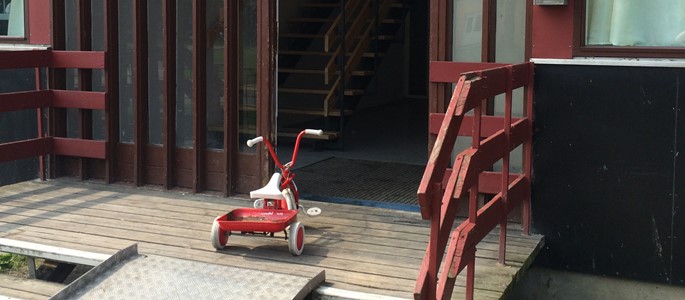A Childhood in No Man's Land
Hundreds of children spend a large portion of their childhood in Danish asylum centres, and with extremely weak legal rights.
INFO:
Roughly one third of the asylum seekers in Denmark are children under the age of 18 and an increasing number of these children are unaccompanied minors. Some children are granted asylum after a few months in an asylum centre, others end up spending their entire childhood in the state of emergency that constitutes the asylum system and get broken down psychologically.
Over 100 children have spent more than 4 years at asylum centres, some more than 10 years. Between 2008 and 2012, alternating governments acknowledged that children whose asylum applications had failed were so fundamentally damaged by living in ordinary asylum centres that they should be moved to more regular housing conditions.
Now, the opposite is the case: just a few months ago, children in need of special care began to be moved to the deportation centre at Sjælsmark, which is run by the Prison Service, with the declared intention of pushing the parents to the point of wanting to leave Denmark voluntarily.
Denmark has a practice for asylum seeking children that is contrary to their human rights and which also represents a stark contrast to the treatment received by Danish children.
The majority of children, whether they come here alone or with their families, only wait in asylum centres for a year or two at the most – which is an awfully long time for a child. Afterwards, they’re are either granted asylum and are moved out into a local municipality or their application is rejected and they are deported to their homelands, either voluntarily or by force. However, a small group end up getting stuck as they have been rejected but for one of several reasons, cannot be deported.
In Refugees Welcome, we have fought on behalf of these children for many years. We don’t think that children should live in asylum centres for years. We also mean that there is a tipping point after which the child’s connection to Denmark should be given more weight than discussions with the parents about returning home.
Below, we explain the most important challenges for asylum-seeking children and illustrate some of them with examples of children we are in contact with.
CONTENTS:
Unaccompanied or accompanied children
Accommodation of children
When is one a child?
Age and maturity assessment
The Convention on the Rights of the Child and asylum-seeking children’s rights
Children’s own motives for seeking asylum
Can sick children be granted residency?
When the connection to Denmark becomes the strongest
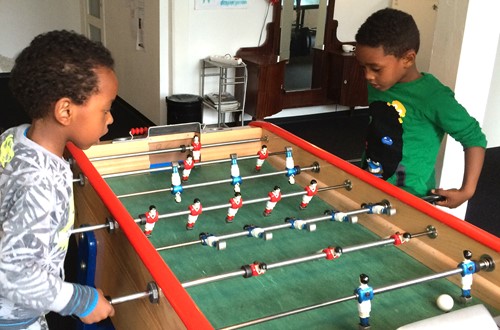
Taufiki with a friend at Trampoline House
TAUFIKI is 9 years old and has lived in various Danish asylum centres for 7 years. He was born in a refugee camp in Uganda and his mother and father are from Congo. He can’t remember his father and his two older siblings, who most likely died when he was small. Recently, he and his mother were moved to the deportation centre at Sjælsmark, which is run by the Prison Service. Until the move, he had lived with his mother at a care centre and attended a special school, where he received special support and teaching because he has developmental issues and trouble concentrating. His problems are a result of the uncertain situation he lives in.
Since the move to Sjælsmark, his condition has worsened dramatically. Several years ago, he and his mother were imprisoned by the police and the next day, put on a plane to Congo. However, the authorities there rejected them, so the police were forced to take them back to Denmark. He fears that this could happen again at any time and therefore refuses to eat in the canteen, where members of the police are present. His mother recently found a knife, which he kept under his pillow at night. Several times a day and every night, he wets the bed. Refugees Welcome have applied for residency after paragraph §9c1, the needs of the child.
Unaccompanied or accompanied children
Previously, almost all children came to Denmark together with their parents: accompanied. They live in asylum centres together with their family members and their asylum case is dependent on that of their parents.
The last few years, the number of unaccompanied minors has increased – at one point in 2016, the percentage of unaccompanied minors was up at 24%. They are typically 14 – 17 years old and come alone, without their parents.
A smaller group arrive without their parents but in the company of others who can be seen to have taken responsibility for the child, often older siblings or grandparents. They are called accompanied minors and can also be very young.
Finally, there are the children who have not yet arrived in Denmark but who hope for family reunification when one, or both, of their parents get asylum. These constitute the largest group, as the majority of asylum seekers arrive alone and then apply to have their children brought here. Most do what they can to avoid exposing their children to the dangerous journey over the sea with smugglers.
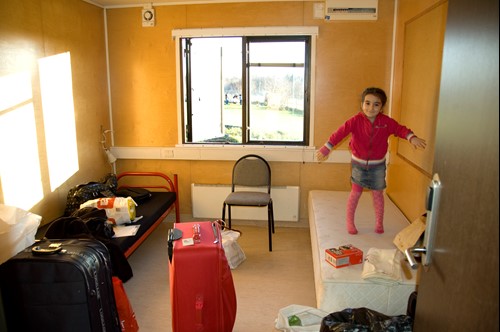
Accommodation of children
The asylum centres are run by the Red Cross or individual municipalities, and the majority of them are located in thinly-populated areas of Jutland. You cannot choose which centre you live in and there is only very limited potential for living privately with a family or friends. The centres open and close all the time, depending on the numbers and the decisions of the municipality. This means that many children have lived in 7, 8 or 9 different centres, from Langeland to northern Jutland.
Accompanying and accompanied children live together with their families in regular asylum centres. A family normally has two small rooms and in some cases, also their own kitchenette and bathroom. Children normally go to a small kindergarten at the centre during the day and school children are driven to a special school for asylum-seeking children. When they have a high enough standard of Danish, they can begin to attend a Danish public school.
The unaccompanied children live at special children’s centres, which are smaller, and where there are greater numbers of staff and a better range of activities. They attend special asylum schools, just like the other children. When they turn 17 or are deemed to be over 17 on the basis of an age test, they can no longer live at the children’s centres but must be moved to an adult centre. Their access to school disappears and is replaced by the limited range of activities offered for adults.
If a family lives at a centre with kitchen facilities, they then receive money to make their own food. However, at some of the centres, including the deportation centres, there is only a canteen, where everyone must eat what is served, three times a day. Many children refuse to eat the food from the canteen and are often hungry at other times of day when the canteen is closed.
Recently, they began to move the first children into the deportation centre at Sjælsmark in northern Sjælland. The centre is run by the Prison Service and has a high enclosing fence and access control. The whole intention with this centre is to make life so empty and sad that the rejected asylum seekers will give up and leave Denmark. It’s also planned that the Somali families who have had asylum for several years but who have now had their permits revoked, will also be housed here until their deportation may take place at some point in the future.
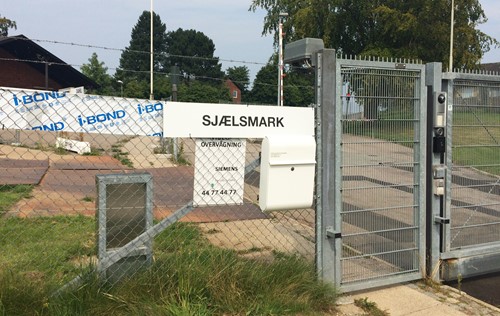
Deportation centre Sjælsmark
When is one a child?
The Convention on the Rights of the Child (CRC) and a range of other international agreements, which Denmark has signed, describe children as ‘persons under 18 years of age, unless the national legislation sets a lower age of legal capacity’. Danish legislation also normally views people under the age of 18 as children. However, the Danish foreign authorities have introduced another limit in practice, namely, 15 years. If an immigrant or refugee tries to have their child brought to Denmark, they will be processed according to a different paragraph and a much harsher assessment if the child has already turned 15.
The same applies if the child has residency here in Denmark and then applies to have their parents and siblings brought here – the chances are poorer if the child is over 15. In these assessments, you can read that they child is not deemed to have the same need of care as a younger child and that other family members can fulfil that need.
Similarly, unaccompanied minors usually live in special children’s centres with higher staff ratios and better conditions, but the 17 year olds are now being moved to adult centres – even in cases where it means separation from younger siblings.
Despite having their asylum applications rejected, some few unaccompanied minors are granted residency after a specific paragraph if they have no familial network in their homeland. This is, however, revoked as soon as they turn 18, unless they are exceptionally well-integrated and have been here for many years.
Age and maturity assessment
Almost all asylum-seeking children arrive without a passport or other identification. A birth certificate can perhaps be acquired but this cannot always be verified as authentic. In many of the world’s countries the authorities don’t issue papers to children before they begin attending school and registration can consist of a piece of card with a handwritten name and a stamp. A large number of children from Afghanistan and African countries don’t know precisely what date they were born on – the day is not celebrated and it has no great significance.
However, in Denmark it’s a big problem. For children who arrived with their parents (accompanied) it’s important to know their age in terms of school start, health and development. Children’s ages are almost always registered on the basis of information provided by the parents without any further investigation, even if the parents themselves aren’t entirely sure. An incorrect date is frequently assigned due to lack of an interpreter or different calendar systems.
The case is different for unaccompanied children as their situation is in many ways determined by whether or not they are under 18 years of age. Their words are not always taken at face value as there can be advantages to be gained by claiming to be younger and some of them do just this. Unless they are obviously younger than 15-16 years of age, they will be sent for an age test at the Forensic Institute. The assessment is made on the background of x-rays of their teeth and the bones in the hands as well as the body’s visible development. The result is far from certain and based upon a probability calculation which shouldn’t be lead to the exact divisions that it does.
Children who are still outside of Denmark, but whose parents have been granted residency here, are entitled to family reunification. Their age is also very important, as children over the age of 18 cannot be brought to Denmark. If these children can’t provide ID documents, they will be asked to submit a mouth swab at a Danish embassy, which is then compared with their parent’s DNA. In a similar case, a High Court ruling has dismissed an age assessment.
A new phenomenon is the fact that the youngest of the unaccompanied minors are no longer seen as mature enough to go through the asylum procedure – they can be as young as 10 years old. Instead of giving them a temporary residency visa until the turn 18, they are given status as ‘rejected’ and must remain living at asylum centres for an open-ended period, until the day they are deemed mature enough for an asylum assessment. Recently, the Danish Refugee Council has sent a request for enquiry concerning this issue to the Ombudsman. There are currently at least 26 children in exactly this situation.
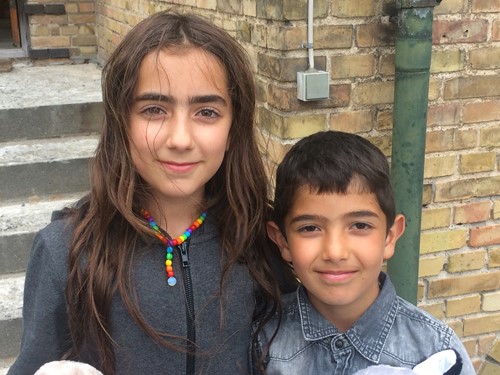
Herine and her little brother Smbat
HERINE is 11 years old and has lived in asylum centres since she came to Denmark as a 2-year-old, in other words, for 9 years. Her little brother of 8 years of age was born here. The family have been rejected during all these years but it has not been possible to send them back to Armenia where they come from, partly because the parents – on the basis of bad advice – claimed a different nationality on their arrival. The family have never been granted permission to live outside of asylum centres, something the majority of other families were granted permission to do after 2012. This is because many years ago, Herine’s otherwise extremely calm, polite father lost his cool one day, as no-one would take his daughter’s bad tooth infection seriously and send her to a dentist.
Even though he neither threatened nor was physical towards anyone, the staff contacted the police who then gave him a fine for threatening behaviour. That action has meant that the family have never had permission to move away from the centre in all the years they have been here. Both children are fully integrated and bright, but Herine has already attended 3 different schools, due to being moved around between centres. Recently, they were moved from Amager to Jutland. Herine’s mother has a mental illness diagnosis and both Herine and her little brother have begun to be affected by the instability of their situation, and they react with separation anxiety, crying fits, angst, depression and disturbed sleep. In 2014, Refugees Welcome applied for residency with regard to the needs of the child on the basis of the length of their residency and has recently resubmitted another application.
The Convention on the Rights of the Child and asylum-seeking children’s rights
Children are a vulnerable group, to whom states should provide special care. The Convention on the Rights of the Child (CRC) notes a list of areas where children’s rights must be ensured. The most basic is the need to take consideration as to what is best for the child (art. 3), secure the child’s right to life and development (art. 6), protection against discrimination (art. 2) and the right to be heard (art. 12). However, Denmark first signed up to the convention in 1991 and it has still not been incorporated into Danish law. We have, however, recently been granted access of appeal to the UN’s Children’s Committee.
As a rule, children in asylum centres begin at a centre school with a limited timetable and standard and are then moved over into a local public school when their Danish proficiency is sufficient. They can, however, be forced to move schools at any time, if the asylum centre closes or if it is decided that the family should be moved to a deportation centre.
Children attend the doctor and nurses at the centres and are offered a vaccination program and other things on an equal standing with Danish children. Yet Denmark is the only Scandinavian country where, in practice, asylum-seeking children don’t have full access to health services, something that was demonstrated by a study from 2013.
Children’s own motives for seeking asylum
Roughly speaking, if you come here together with your parents, you’re essentially seen as baggage to their applications and are not seen as a subject with its own rights, opinions and motives. Children with parents are not summoned for any interviews, not even if they are over 15 years of age. Parents aren’t even asked if their children have any problems or are exposed to any risks in their homeland. The motives for asylum, which the UN lists as being typical for children – forced marriage, forced labour, FGM (female genital mutilation), kidnapping, human trafficking, forced child labour – very rarely grant access to asylum in Denmark. Children are rarely present at meetings with the Refugee Appeals Board. It was only recently that the Immigration Service – after criticism from the media – began to enquire as to the risk of FGM for girls from Somalia. The Immigration Service has also only just begun to grant asylum due to the risk for FGM.
According to both the CRC and the guidelines issued by the UN’s High Commission on Refugees, children must be heard in all cases that involve them – and this includes asylum applications. Children’s motives for asylum should be specifically investigated and they must also be asked in person, in the extent to which they are able to explain themselves and so long as it is in their own interest. It must of course never be the case, that children are questioned with a view to discovering weak points in their parent’s stories, but children should be seen as independent individuals with their own personal experiences and they should be allowed to express their opinions.
In 2016, the UNHCR, UNICEF and the Danish Refugee Council published a compendium in Danish with the title ’Når børn søger beskyttelse’ which can be downloaded here. It includes a chapter on how to ensure the best for the child during the Danish asylum process.
On the other hand, you could say that unaccompanied minors are treated as adults when it comes to their motives for asylum – it is expected that that have an independent motive and are capable of explaining it, just as an adult would.
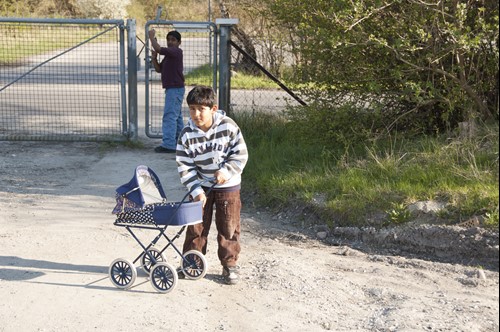
Boys in the asylum centre at Kongelunden
SAJAD came to Denmark with his parents and younger siblings when he was 10 years old. The family comes from Afghanistan but had previously lived for many years as refugees in Iran. Their application was rejected and during the proceeding five years, the mother became seriously mentally ill and unable to take care of her children. Gradually, Sajad became affected by the uncertainty in the asylum centre and his worries concerning his mother’s suicide attempt. This led to a depression and periods during which he couldn’t face going to school. He was an otherwise good student, who went to a normal public school and had many Danish friends. Refugees Welcome applied for residency on the basis of Sajad’s situation, but it was rejected with the argument that it was his parents’ responsibility to travel home and that they must provide for his future in Afghanistan.
At the same time, the family had applied to have their asylum application reopened because they had converted to Christianity. Unusually, their lawyer insisted on summoning Sajad, who was just 16 at the time, to attend the council meeting. It was him who had the strongest faith and connection to the local church, which had led to him almost being excluded by his Muslim friends. The case ended with the family being granted asylum on the basis of Sajad’s faith and the risk it would pose to the family in Afghanistan.
Can sick children get residency?
Some of the children who seek asylum in Denmark have been exposed to traumatic experiences in their homelands and on the journey here. Not enough attention is paid to this. However, living in Danish asylum centres actually has an even worse effect on children’s mental health.
It is now well documented that children are negatively affected by residing in asylum centres and living a life where their futures are uncertain. In the book, "Asylbørn i Danmark – en barndom i undtagelsestilstand" (Hans Reitzels Forlag 2011), the two researchers, Katrine Vitus and Signe Smith Nielsen, collated a series of analyses and investigations. The conclusion is clear: children need to be able to visualise their futures and they need to live under conditions that are predictable and secure. When they grow up in multiple asylum centres, with traumatised and nervous adults, with the fear of being picked up by the police and put on a plane somewhere at any given moment, the very quickly develop symptoms of angst, sleeping problems, difficulties concentrating, aggressive behaviour and apathy.
Many also experience either one or both of their parents developing mental illness during the many years of their time in the asylum system. This naturally also has an impact on the children and can even result in the children being removed from the parents.
At some point, the children have perhaps become too sick to deport and the question also exists as to whether they will have access to the necessary treatment in their homeland – or, if the only effective treatment is to be granted residency. In their statements on asylum-seeking children, many child psychologists and psychiatrists have written that the child needs calm and security in order to thrive. Immigration Law’s §9b provides the opportunity for humanitarian residency due to, among other reasons, illness. However, in practice this doesn’t apply for children. Refugees Welcome undertook a manual audit of 80 positive rulings on humanitarian residency between 2011 and 2015. The count revealed that in just one case was residency given to a child, and this child was suffering from kidney-failure, a very rare diagnosis for a child. In the other cases, residency was granted on the background of diagnoses which children almost never have: paranoid psychosis, schizophrenia, heart disease, cancer, dementia, Parkinsons and so on, and most often, a combination of several of the above. The time the applicants had spent in Denmark (as rejected asylum-seekers) was on average 800 days after the initial rejection. Hundreds of children with diagnoses such as developmental issues, depression, angst, multiple handicaps and epilepsy have had their applications rejected.
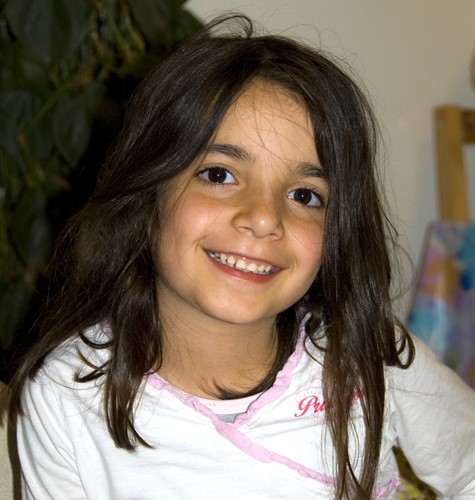
Beri, photo from 2009
BERI was born in Denmark in 2002, four years after her parents, stateless Kurds, were forced to flee Syria. Beri spent the first 11 years of her life as a rejected asylum-seeker in various asylum centres. She experienced many times, how her friends were collected by the police at 5am – and that you never heard from them again. Or that friends were granted asylum and moved out to a far-away municipality. She therefore stopped developing friendships and instead spent her time in front of the television. In school, she was increasingly short-tempered and controlling and she began to have difficulties sleeping more than a few hours at a time. That her mother was mentally ill and her father a torture-survivor naturally didn’t help with the problem. Despite several diagnoses of angst and depression from child psychiatrists and various different applications for humanitarian residency, the family were first granted asylum in 2012 due to the outbreak of war in Syria and not out of regard for Beri.
When the connection to Denmark becomes the strongest
When a family’s application is rejected, it is responsibility of the parents to travel home or find another solution for the family’s future. However, it’s not always this simple. And in some cases, families can become stuck and end up staying here for many years. During this time, the children become utterly Danish and forget everything about their homelands, which they may not ever even have seen. And their condition gets increasingly worse.
Danish legislation contains several options in terms of acquiring residency: if deportation is hopeless (§9c sec. 2), if the applicant is seriously ill (§9b) and out of consideration for child’s needs, for example in terms of many years connection to Denmark (§9c sec.1). However, each of these factors is not enough and in practice, very few permissions for residency are granted after these paragraphs each year, due to the highly restrictive practice outlined by the Minister.
In the rejected cases, there is no review of what best meets the needs of the child. For example, no distinction is made between which homeland is involved and what the child’s prospects in terms of security, healthcare and education will be in that country. If you need to make a decision based on the best interests of the child, there are differences between being sent back to Afghanistan, Congo, Turkey or Thailand.
Typical reasons for rejected applications include:
• The family not co-operating in terms of deportation
• It is the parents’ fault, that the child has been in Denmark for so many years
• So long as their stay here has been illegal, connection to Denmark cannot apply
• The child or parents don’t have a serious enough diagnosis.
There are no current audits concerning the length of time asylum-seeking children spend here, but the table below shows that 128 children had been in the asylum system for more than 4 years as of December 2016. A review from 2013 showed 42 children with over 4 years residency while in 2014 the total was 52.
Download: Diagram showing length of residency for children 2016
In response to MP Johanne Schmidt-Nielsen (EL) in October 2015, minister Inger Støjberg (V) actually stated that the length of a child’s time of residency in Denmark can be sufficient to result in a residency permit: “There must therefore, in all cases where a child applies for a residency permit in Denmark, be undertaken a concrete assessment of the extent to which the circumstances of the case are proportional to impart a rejection of the application, and this assessment must take the child’s best interests into consideration. Depending on the specific circumstances of each case, a child can earn an independent right to residency in Denmark on the basis of the length and character of the child’s stay in Denmark and with regard for Denmark’s international obligations”.
Since 2014, Refugees Welcome has applied for residency on the basis of the best interests of the child for a total of 27 children from 11 families with a minimum of 4 years stay in Denmark and 5 of the families have been granted residency. In the 5 cases, there was a short period of legal residency during this time or the parents were not capable of taking care of the children themselves. The length of their stay and the connection to Denmark were therefore not enough by themselves. The only case we are aware of where this has been in the case (and here there were also psychological problems with both the children and parents) is that of the Afghan Rokhsar, whose story was told in the documentary “Mon de kommer om natten” and who shortly afterwards was granted a residency permit after 6 years illegal residency. However, Malak, whose story was written about in Politiken in July 2017, was rejected, despite having been in Denmark for 11 years.
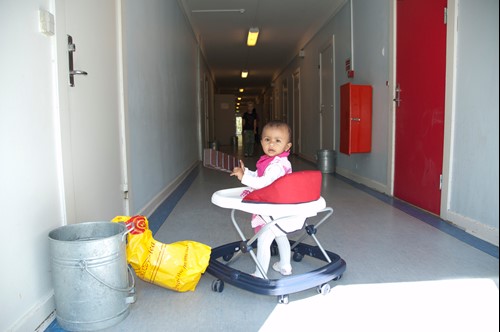
Baby, Avnstrup asylum centre
A PAIR OF TWIN BROTHERS arrived eight years ago alone to Denmark from Sri Lanka as 16 year olds, directly from the last ghastly months of the civil war there. They had lost contact to their mother and sister, and an uncle had helped them get to Europe. After a process which stretched over several years, they were rejected, both for asylum and the special residency occasionally granted to unaccompanied minors without a network, even though no-one could find their family. The boys had developmental delays and it took them a long time to learn Danish. On top of this, one of them in particular suffered from nightmares and angst after what they had experienced in their homeland. When the turned 18, they were moved to the care centre at Kongelunden, where they lived for several years. Refugees Welcome appealed to the UN’s Human Rights Committee over the case and the appeal was upheld. However, when the case was finally re-opened by the Refugee Appeals Board, they were rejected once again. An application for residency on the basis of their unusually long, procedural stay and their strong connection to Denmark, where they had, after all that time, developed many friendships and one of them had a girlfriend, was also rejected by the Immigration Service. The boys have since disappeared.
Read more (in Danish):
"Når asylcentre bliver barndomshjem" kronik i Kr. Dagblad af præst Niels Nyman Eriksen sept. 2017.
"Mindst 120 børn har levet mellem 4 og 12 år det danske asylsystem" Politiken juli 2017.
"Afviste asylbørn er dansk politiks kastebolde" Politiken juli 2017.
You can help Refugees Welcome provide
free legal help to the rejected children!


